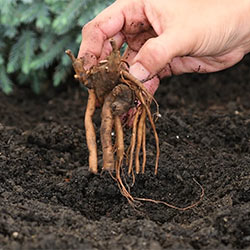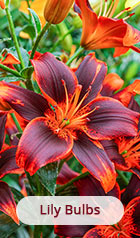Thank You!
We have received your request. You will be notified when this product is in stock.
X
Daylily bulbs grow best when planted in full sun or partially shaded areas that receive several hours of direct sunlight each day. Thanks to modern breeding efforts, today's gardener can choose from so many varieties of daylilies--including ones with multiple colors, ruffling, and reblooming qualities. In the garden, they have so many uses. Choose shorter varieties to plant along the edge of a flowerbed and select a few showy varieties for your mixed perennial flowerbed. Or, plant daylily bulbs in large groups for a stunning display.
How do you take care of daylily bulbs?
Daylilies perform best when they're planted in full sun: most varieties prefer a bare minimum of six hours per day. Like most sun-loving perennials, hemerocallis prefer well-draining soil and don't abide soggy roots. Beyond providing good growing conditions, daylily bulbs will grow well on their own nearly anywhere! You don't even need to fertilize daylilies, although a springtime application of a balanced fertilizer or composted manure can help increase their blooming, and a fall application of the same can help them prepare for winter. Daylilies are naturally prolific bloomers and are hugely adaptable plants -- just get your daylilies planted and watch them flourish!
When do daylilies bloom?
June is peak daylily season: on a walk in any residential neighborhood in the United States, you're likely to spot a few tall, attractive daylily blooms at that time of year. In fact, many communities across the U.S. host daylily festivals, nearly all of which take place in late June! Daylilies are known for their long blooming season and flower power: each stem has several floral buds, so daylily blooms last several weeks instead of several days.
However, cultivar and location make plenty of difference for daylilies -- just as is the case with any other perennial. Some varieties of early-blooming daylilies may blossom in May or even April. In far northern regions, such as New England, daylilies might hold off on blooming until July or August. And, reblooming daylilies show off with several rounds of flowers right through the blooming season! Reblooming daylilies like the classic Stella de Oro start blooming in late spring, and produce blooms all the way through summer.
When should you plant daylily bulbs (roots)?
If you find your daylily bulbs for sale online, the answer is simple: you should plant your daylilies when you receive them. Here at Michigan Bulb, we ship our daylilies just when they should go into the ground. If you're buying daylilies locally, plant them in the spring when the temperature is still cool. Springtime planting gives daylilies plenty of time to establish themselves before winter!
When you're planting, dig a hole deep enough to accommodate the roots without bending them. Roots should be an inch or two below the soil surface, and the crown (where the roots meet the stems) should be level with the soil. Water your daylilies in well, and wait for them to grow out and up!
Do daylilies spread?
Daylilies do multiply, but they don't spread without assistance. Every few years, you should divide your daylilies to keep them flowering well. The best time to divide is in late summer, right after the end of the flowering season. When it comes time to divide your daylilies, dig up the daylily clump -- you'll notice that it's grown quite a bit in just a few years! -- and cut the stems back to a few inches above the crown. Use a sharp knife to divide the clump into smaller clumps, with several stems per clump and good roots on each piece. Then, replant your daylilies -- either in different areas of the yard, or in one big group. Be sure to plant them at least 18 inches apart, so they have room to multiply again.
What kind of daylily should I choose?
There are plenty of aspects to consider when deciding which type of daylily to plant in your garden. In addition to height, shape, and color, daylily cultivars bloom at different times during the season. While nearly all daylilies grow long, slender leaves, the hardiness and color of that foliage varies by type. Here are a few elements to consider when choosing daylilies:
Bloom time: Early-blooming Daylilies, Mid-Blooming Daylilies, or Late-Blooming Daylilies?
As you shop for daylilies, consider the mix of plants in your garden. Early season daylilies bloom in May or June, and may bloom again in fall. Midseason daylilies bloom in the middle of summer, and late-blooming daylilies bloom in August, or even into the fall. Think about mixing up the bloom times of your daylilies to get a continuous bloom all season long: if you plant varieties with different bloom times, you'll never be without flowers.
One of the best ways to get a big boost for your garden: plant reblooming daylilies. Reblooming daylilies bloom throughout the summer -- they typically have a main blooming period, followed by repeated blooms right up until frost sets in. By deadheading reblooming daylily varieties, you can keep the plants tidy while additional buds form and open.
Foliage type: Deciduous, Evergreen, or Semi-Evergreen Daylilies?
Some daylilies have foliage that stays evergreen through the winter, and even produces new leaves over winter in milder climates. Evergreen daylilies hold their foliage color through winter, except in very cold climates. Deciduous daylilies are more of a standard perennial, dying back completely as winter approaches and "spearing" back up through the ground in spring. Semi-evergreen daylilies are any of a wide variety of daylilies in the middle: these retain some leaves through the winter.
Breeding: Diploid versus Tetraploid Daylilies?
"Diploid", "Triploid' and "Tetraploid" are terms referencing the complement of chromosomes held by plants. Most plants are diploids, containing two identical sets of chromosomes in each cell. Plants with three sets of chromosomes are called Triploids, and those with four sets of chromosomes are tetraploids.
Diploid daylilies are more common, and comprise many of the classic daylily varieties, as well as several types of double daylilies. Triploids are rarely seen as they are usually infertile. Tetraploids tend to have bigger, brighter flowers, and feature more vigorous foliage. Many "new '' daylily varieties are tetraploids, as the increased number of chromosomes allows for better breeding.






















